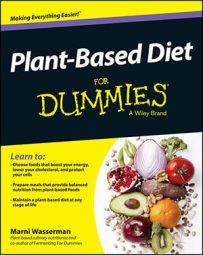Ancient grains are some of the oldest foods on the planet. They’ve been used for thousands of years and are an excellent source of complex carbohydrates, which help curb appetite. These grains also contain phytochemicals, which can help lower cholesterol and prevent cancer and other diseases. When combined with legumes and vegetables, whole grains provide complete nourishment!
Here are some handy grain how-tos:
Consume one to two servings each day (1/2 cup or one slice of bread is equivalent to one portion of grain).
Focus on gluten-freewhole grains (brown rice, quinoa, millet, amaranth, and buckwheat). These types of grain are much easier to digest and contain a variety of nutrients. They also cook quickly.
Choose alternatives to wheat (spelt, kamut, oats, barley, and rye).
Choose sprouted-grain products. (I like Ezekiel 4:9 breads and wraps because they’re full of fiber and protein, are easy to eat, and make great sandwiches.)
Use these grains in their whole form or as ground flours, in pastas, breads, wraps, and crackers.
The following table runs down what the different grains are and how to prepare and store them. Refer to this table if you need additional cooking tips.
| Name of Grain | Health Benefits | How to Use It | How to Store It |
|---|---|---|---|
| Barley: A rich and chewy grain | Barley is an incredible source of soluble fiber and B vitamins. Both are essential for lowering cholesterol and protecting against heart disease. | After rinsing, add 1 part barley to 3-1/2 parts boiling water or broth. After the liquid returns to a boil, turn down the heat, cover, and simmer for 45 minutes. | Store barley in a tightly covered glass container in a cool, dry place. You can also store it in the refrigerator. |
| Brown rice: A grain that’s more wholesome than white rice; the unhulled and unmilled version | Brown rice is light, gluten-free, and an incredible source of long-lasting carbohydrates for energy. It’s also high in fiber and contains several vitamins and minerals, as well as protein. | After rinsing brown rice, add 1 part rice to 2 parts boiling water or broth. After the liquid returns to a boil, turn down the heat, cover, and simmer for about 45 minutes. | Because brown rice still features an oil-rich germ, it’s more susceptible to becoming rancid than white rice and should therefore be stored in the refrigerator. Stored in an airtight container, brown rice will keep fresh for about six months. |
| Kamut: A type of ancient wheat that’s high in protein | Kamut has 20 percent to 40 percent more protein than wheat and is richer in several vitamins and minerals, such as calcium and selenium. | Soak 1 cup kamut overnight. Then add 3 cups water and bring to a boil, add a pinch of salt (if needed), turn the heat to low, and simmer for 40 to 45 minutes or until tender. | Store kamut in a tightly sealed glass container in a cool, dry place. |
| Oats: A category that includes oats, oat bran, and oatmeal | Oats contain fiber, which helps lower cholesterol levels. Oats are also beneficial for stabilizing blood-sugar levels and contain antioxidants, which reduce the risk of cardiovascular disease. | For all types, it’s best to add oats to cold water and then simmer for 10 to 30 minutes, depending on the variety. For raw porridge, soak rolled oats overnight for a ready-to-go breakfast in the morning. | Store oatmeal in an airtight container in a cool, dry, dark place. It will keep for approximately two months. |
| Spelt: An ancient grain with a nutty flavor | In addition to being an amazing source of fiber and niacin, spelt is easier to digest than wheat. | After rinsing, soak spelt in water for 8 hours or overnight. Drain, rinse, and then add 3 parts water to 1 part spelt. Bring to a boil, then turn down the heat and simmer for about an hour. | Store spelt in an airtight container in a cool, dry, dark place. Keep spelt flour in the refrigerator to best preserve its nutritional value. |
| Rye berries: Rye berries look like wheat but are a little longer and more slender. | Rye berries help with weight loss, gallstone prevention, and diabetes management. | After rinsing them, bring 1/2 cup rye berries, 1/4 teaspoon sea salt, and 1-3/4 cups water to a boil. Reduce heat, cover, and simmer for about an hour. | Store rye berries in a cool, airtight container. It will keep up to six months in the pantry or a year in the freezer. |
| Wheat berries | Wheat berries are an excellent source of fiber, folic acid, protein, and other nutrients. | After rinsing wheat berries, soak them overnight. For 1 cup berries, use 2 to 2-1/2 cups water and bring to boil. Cover and let simmer for 1 to 1-1/2 hours. | Store wheat berries in an airtight container and keep in a cool, dark place. Food-grade storage pails are a good option. |
Now, grains aren’t the only game in town. Other beneficial sources of complex carbohydrates include:
Fruits: Organic, seasonal, low-glycemic fruits, such as apples, berries, and pears
Legumes: Lentils, chickpeas, split peas, kidney beans, pinto beans, and black beans
Starchy vegetables: Squash, sweet potatoes, yams, carrots, and beets

